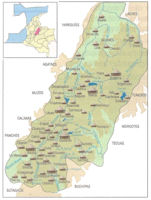Early Colombia - Muiscas
 The El Dorado legend is world famous and centers on Guatavita lake, close to Bogota, which was one of the sacred lakes of the Muisca people. Their chief, nicknamed El Dorado or The Golden One by the Spanish, covered himself in gold dust and dived into the water in a ritual, with his worshippers throwing gold and precious stones after him.
The Muiscas were a very important indigenous group Chibcha family. They reached a very complex political and social organization, with large economic developments in various fields. Muiscas peoples settled in the Cundiboya highlands. Muiscas were located there from 311 BC, in the current departments of Boyaca and Cundinamarca. The most important cities of this community were Bacatá and Hunza, in the areas now they called Bogota and Tunja.
The El Dorado legend is world famous and centers on Guatavita lake, close to Bogota, which was one of the sacred lakes of the Muisca people. Their chief, nicknamed El Dorado or The Golden One by the Spanish, covered himself in gold dust and dived into the water in a ritual, with his worshippers throwing gold and precious stones after him.
The Muiscas were a very important indigenous group Chibcha family. They reached a very complex political and social organization, with large economic developments in various fields. Muiscas peoples settled in the Cundiboya highlands. Muiscas were located there from 311 BC, in the current departments of Boyaca and Cundinamarca. The most important cities of this community were Bacatá and Hunza, in the areas now they called Bogota and Tunja.
Muiscas had a political organization and social hierarchy. At the head of society were the rulers, whose authority and power were absolute. They were followed by the priests, with powers magical, religious and great wisdom to advising rulers. The basis of society was the village dedicated to agriculture, fisheries, the crafts and mining. The classes were identified by clothing, because the common people used white clothes and important gentlemen wore colorful clothes and jewelry. The society was formed by meetings of Twenty homes under the domain of middle managers.
The main authorities were the Zipa Muiscas Bacatá and Zaque Hunza. These heads the people paid them tributes or taxes in kind; that is, they gave part of their crops or some objects made by them as blankets, ceramics, jewelry or salt. Likewise, they paid taxes in the form of work, building houses, roads, bridges and working the land of the The Zaque ruled Zipa and advised by a council of elders, who were the wisest people in the community.
In the upland, corn and coca gerw in temperate lands, and cassava, corn, parsnips, cotton, guava and pineapple. Important economic activities of the community administrators would supply the entire society. Muiscas also traded with other remote highland communities. They used for trade or barter exchange products, and in other cases used blankets, teiidos of cotton or salt cakes as currency.
Muiscas featured art and jewelry. They developed techniques for the production of parts such as lost wax, hammering and laminate. These pieces are nose rings, bracelets, headbands, pectorals and necklaces. Most of them were used in ceremonies. In the field of ceramics, Muiscas excelled in developing musical instruments and vessels.
Muiscas most important products were pottery, basketry, textiles and salt extraction mines of Nemocón and Zipaquirá, and emeralds in Muzo. Goldsmithing was an important activity for the muisca people. It is mainly had a religious sense and most manufactured parts were used as offerings to the Gods. Another part of these pieces were used as ornaments among people as rulers.
Muiscas were polytheistic, that is, they worshiped several gods the Sun, they called Sue, and the moon, which they called chia. The temple of the Sun god was near modern Sogamoso and the temple of the Moon was located in the current Chía. Bochica was the god who had taught them to work the land and arts, and Bachué the fertility goddess who emerged from a lagoon to populate the earth and returned snakelike to the lagoon.
The gods created men and taught them to fend for themselves, protected them from evil spirits, possible attacks of other peoples and natural disasters such as droughts or floods, which should be thankful for the people. The ceremonies to the gods were frequent, and they were always led by the top rulers and priests. In them, offerings were made and celebrated with abundant food and chicha. Muiscas were also great creators of myths and legends to explain the forces of nature and existence of being human. As it was thought that the rulers were the incarnation of the divine powers, Muiscas worshiped their lords keeping them mummified after death.
They believed in the immortality of the soul, so who performed ceremonies, rites, music and burials with grave goods that Muisca made, such as gold pieces, ceramrcas, stones one of the parts best known precious gold, food and blankets. the Muisca culture. When a ruler, besides the trousseau funeral, the Zipa rite called for burying alive his wife to accompany him on the trip to Guatavita, the Afterlife. One of the religious rites that was the most important was washing off the gold coating in the lagoon of Guatavita.
|
NEWSLETTER
|
| Join the GlobalSecurity.org mailing list |
|
|
|

